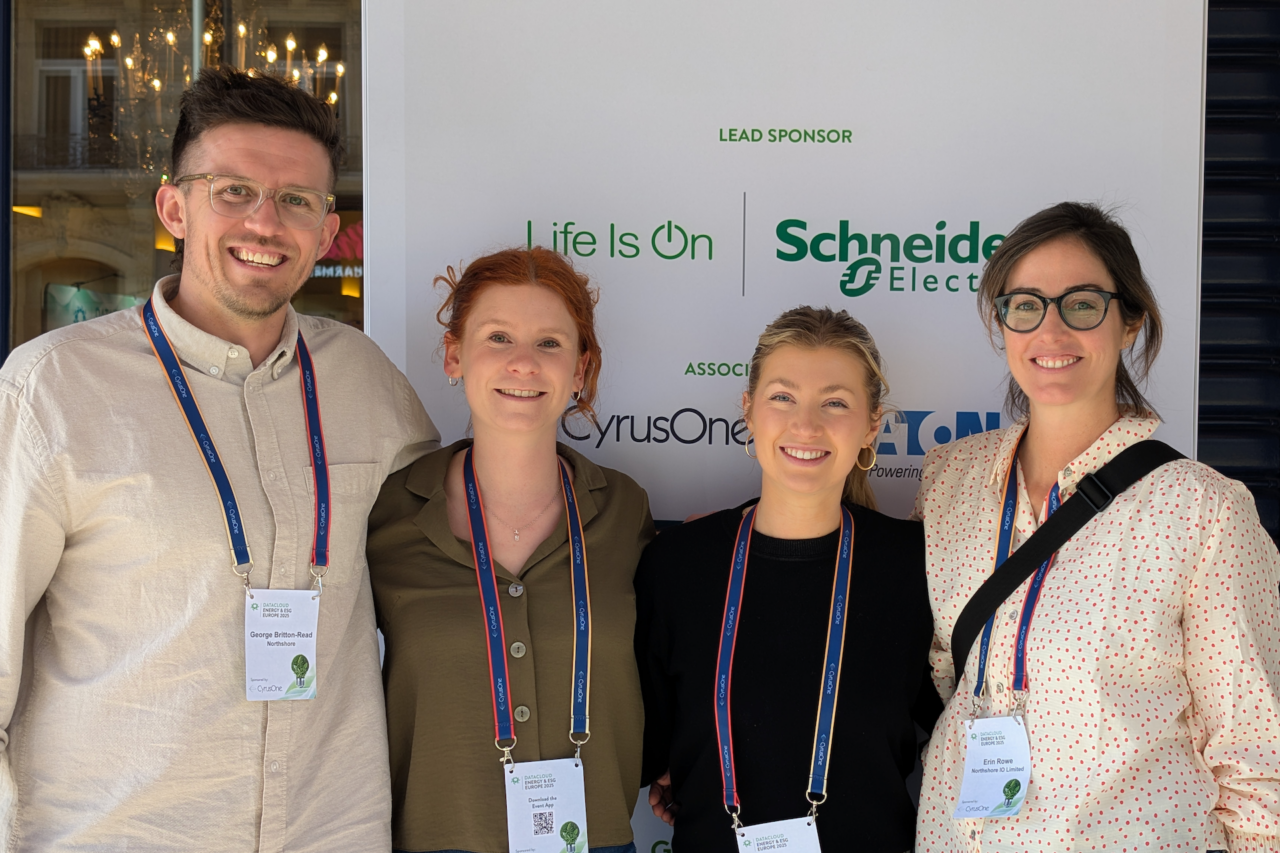The Northshore team has just returned from Datacloud Energy 2025, an event designed to bring together data centers, renewable energy developers, grid operators, and policymakers to collaborate on the industry’s most pressing challenges. With AI accelerating demand for power and sustainability targets becoming more ambitious, the focus was on how infrastructure, energy procurement, and regulatory frameworks must evolve to meet these twin pressures.
The event highlighted that the future of data centers isn’t about choosing between AI growth and sustainability, it’s about finding practical, scalable solutions that ensure both.
Northshore’s Key Takeaways from Datacloud Energy 2025
1. Heat Reuse: A Growing Priority, but Who Takes the Lead?
Heat reuse remains an untapped opportunity for improving efficiency, but narrative at the conference seemed to indicate that data centers do not want to become energy providers. Discussions focused on how the industry needs stronger partnerships with policymakers and utility companies to scale up viable heat reuse projects.
Promising developments include:
- CyrusOne FRA7: Deploying up to 40MW of waste heat to 70 buildings.
- BEOS (Germany): A dedicated energy center designed for waste heat utilisation.
- The Netherlands: A new policy is in development, but uncertainty is stalling projects.
The challenge is not just technological but regulatory. As the industry takes the next step, there will need to be greater clarity and financial incentives for operators to confidently commit to heat reuse at scale.
2. Grid Connection: The Roadblock Slowing Renewable Adoption
While renewable energy capacity is expanding, grid bottlenecks remain a major hurdle. Right now, 1,600 GW of renewable energy is waiting for grid connection in the EU, but lengthy permitting processes mean new transmission lines can take up to 13 years to build – compared to just 3 years in China and 6 years in India.
Key insights from the conference:
- Some countries, like Belgium, have introduced Grid Hosting Capacity maps to improve transparency on available capacity.
- The UK is addressing the issue by clearing out “zombie projects”—a move that could help free up stalled grid connections.
- Grid operators want utilisation signals from data centers to optimise energy distribution, but adoption remains slow.
For AI-driven data centers to meet sustainability targets, faster permitting, grid expansion, and improved transparency on capacity availability will be critical.
3. Nuclear & SMRs: A Long-Term Bet on Energy Security
The conversation around nuclear energy and Small Modular Reactors (SMRs) reflected a growing interest in alternative baseload power sources. However, while nuclear could play a role in decarbonising data centers, its rollout is highly dependent on regulatory and public acceptance.
Developments to watch:
- Newcleo is developing liquid lead-cooled reactors that use reprocessed nuclear waste, with deployment targeted for 2030-2034.
- Tomak is advancing fusion energy, with its first US-funded site expected to be operational by 2032, and wider rollout projected by 2040.
For now, most data center operators remain cautious, with many waiting for real-world case studies before making significant commitments to nuclear.
4. Site Selection & Masterplanning: Beyond Standalone Developments
Despite power availability challenges, FLAP-D (Frankfurt, London, Amsterdam, Paris, Dublin) remains a top choice for new data center developments. Why? Fibre and connectivity are still the dominant factors in site selection.
Masterplanning is emerging as a critical approach – data centers can no longer be considered stand-alone assets. Instead, they must be planned in coordination with:
- Grid operators and planning authorities to ensure power availability and connection timelines.
- Local district heating systems and battery storage networks to maximise energy efficiency.
- Policy frameworks that encourage sustainable site selection and adaptive reuse of existing infrastructure.
The industry is shifting toward long-term, strategic planning that ensures AI growth and sustainability go hand in hand.
5. Regulation & Policy: An Evolving Framework for Sustainable Growth
With sustainability targets and AI-driven expansion accelerating simultaneously, regulatory frameworks are shifting.
- New EU Code of Conduct website launching in two weeks.
- New heat reuse policies are expected in the Netherlands, though uncertainty is causing some projects to stall.
- Energy allocation fairness is a growing concern—should grid access be “first-come, first-served,” or should regulations prioritise sustainability-focused projects?
The UK’s approach to clearing “zombie projects” could serve as a model for streamlining grid access and ensuring that stalled developments don’t block critical infrastructure projects.
6. Energy Efficiency with AI & Automation
As AI workloads grow, they are also driving innovation in energy efficiency.
Key insights from the event included:
- AI-powered energy forecasting is helping data centers predict demand more accurately and reduce wasted capacity.
- Automated cooling optimisation is improving efficiency in high-density environments.
- Machine learning-driven power management is reducing consumption without compromising performance.
With energy costs and sustainability pressures increasing, AI itself may be key to optimising its own footprint.
Looking Ahead
Datacloud Energy 2025 reinforced that AI growth and sustainability are not opposing forces, they must evolve together. The future will be shaped by smarter regulation, adaptive site selection, and increased collaboration between data center operators, energy providers, and policymakers.
At Northshore, we’re focused on how the industry can navigate these challenges with practical, forward-thinking solutions that drive both efficiency and innovation. Contact us to collaborate!
